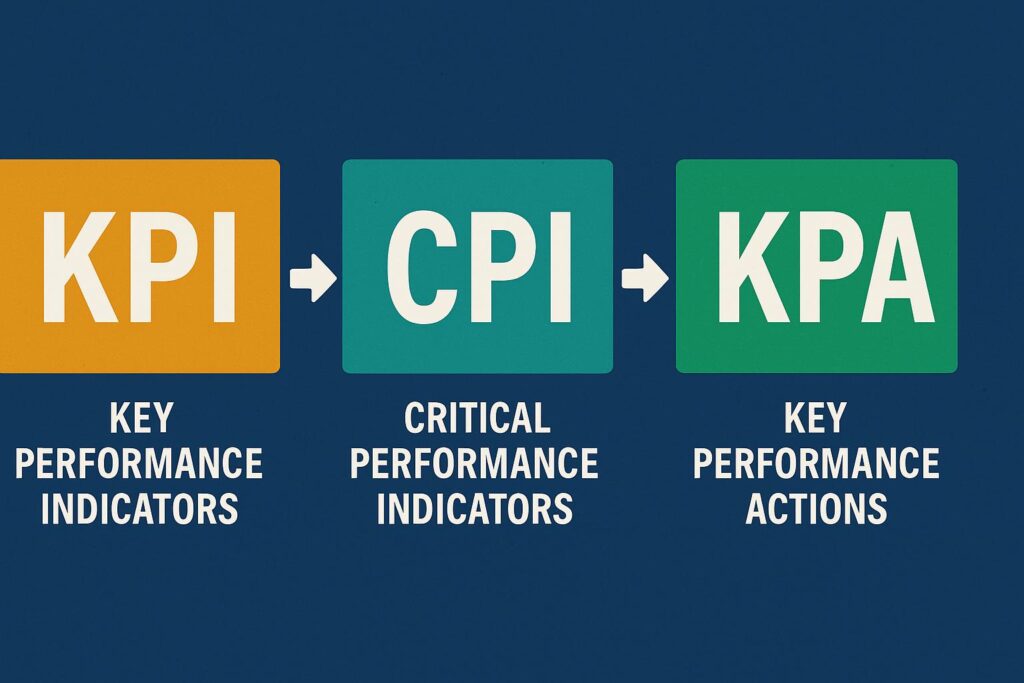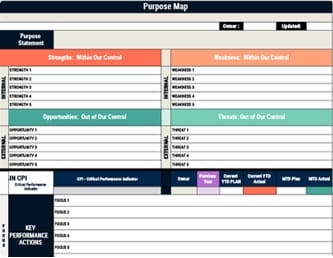When most organizations talk about performance, they point to KPIs—Key Performance Indicators. Revenue. Quality. On-time delivery. Customer satisfaction. But here’s the truth: KPIs tell you what happened. They don’t tell you why it happened.
If you’re serious about executing your strategy and creating a performance management system that actually drives results, KPIs alone won’t get you there. High-performing organizations go deeper. They build an execution system that connects three layers of performance: Critical Performance Indicators (CPIs), Key Performance Indicators (KPIs), and Key Performance Actions (KPAs).
What Are Key Performance Indicators? Complete Definition
Key Performance Indicators (KPIs) are quantifiable metrics that measure how effectively an organization, team, or individual is achieving key business objectives. Unlike basic metrics that simply track activity, KPIs are directly tied to strategic goals and provide insight into whether you’re moving in the right direction.
How to define key performance indicators that drive results:
KPIs serve as your business scoreboard—they show you how the game is going, but they don’t win the game for you. That requires action. Effective KPIs share several characteristics: they’re specific and measurable, aligned with business objectives, actionable (you can influence the outcome), relevant to decision-makers, and time-bound with clear targets.
The difference between KPIs and other metrics: Not every number you track is a KPI. Page views are a metric. Conversion rate from website visitors to leads is a KPI. Hours worked is a metric. Revenue per employee is a KPI. The distinction matters because true KPIs connect directly to business outcomes and strategic priorities.
Beyond Traditional KPIs: Understanding CPIs, KPIs, and KPAs
Most businesses today have dashboards. They know their KPIs. But they’re still underperforming. Why? Because they haven’t installed a daily management system that drives accountability to actions, and they haven’t learned how to connect the dots between activity and outcome.
The solution is building a three-layer performance management system that moves beyond monitoring to execution:
1. Critical Performance Indicators (CPIs) – What Winning Looks Like
CPIs are not just another metric—they are the “vital few” outcomes that define whether your organization is truly achieving its mission. Think of CPIs as your North Star metrics. You can’t win without them.
Critical Performance Indicators examples:
- EBITDA growth
- First-pass yield in manufacturing
- Customer retention rate
- On-time delivery performance
- Market share in core segments
These are lagging indicators, but they reflect whether your business is aligned and executing effectively. A mistake most companies make? They confuse KPIs with CPIs. They measure everything that moves, without clarity on which 3–5 outcomes actually define business success.
How CPIs differ from traditional KPIs: CPIs represent the ultimate business outcomes—the metrics that, if achieved, virtually guarantee business success. While you might track dozens of KPIs, you should have no more than 3-5 CPIs that define winning.
2. Key Performance Indicators (KPIs) – Your Business Scoreboard
KPIs track the conditions, contributors, or behaviors that influence your CPIs. They show you how the game is going—but they don’t win the game for you. That requires action.
Key performance indicators examples by department:
Sales KPIs:
- Lead conversion rate
- Sales cycle length
- Average deal size
- Pipeline velocity
- Customer acquisition cost
Operations KPIs:
- Equipment utilization rate
- Inventory turnover
- Defect rate
- Cycle time
- Cost per unit
Marketing KPIs:
- Cost per lead
- Marketing qualified leads
- Brand awareness metrics
- Content engagement rates
- Return on marketing investment
Human Resources KPIs:
- Employee engagement scores
- Time to fill open positions
- Training completion rates
- Retention rate by department
- Performance review completion
Think of KPIs as the pulse checks across your functions. They help you manage the complexity of your operation, but they must roll up to CPIs. The danger? KPI overload. If everything’s a priority, nothing is.
3. Key Performance Actions (KPAs) – From Metrics to Daily Execution
Key Performance Actions are what separate performance monitoring from performance management. They’re the specific behaviors, routines, and countermeasures that individuals and teams commit to in order to move the needle.
Key Performance Actions examples:
- Daily Tier Reviews with production teams at 8 AM
- Auditing visual management boards every Tuesday
- Following standard work procedures for preventive maintenance
- Escalating safety issues within 30 minutes of identification
- Updating run rate dashboards every shift
- Weekly one-on-one coaching sessions with direct reports
- Monthly customer health score reviews
- Daily stand-up meetings focused on impediment removal
KPAs create ownership. They take strategy off the wall and make it real on the shop floor, in the call center, in the field. Without KPAs, you’re just watching the game instead of playing it.
The CPI→KPI→KPA Execution Loop: Building Your Performance Management System
Here’s what high-performance execution looks like in motion:
Step 1: Define Your CPIs What are the 1–3 mission-critical outcomes that define success for your organization? These should be the metrics that, if achieved, virtually guarantee business success.
Step 2: Identify Supporting KPIs What measurable contributors and leading indicators affect each CPI? Map the cause-and-effect relationships between activities and outcomes.
Step 3: Implement Daily KPAs What specific actions will teams and individuals take daily to move the KPIs? These must be observable, coachable behaviors that create accountability.
Step 4: Create the Feedback Loop Review results regularly, analyze trends, address gaps, and most importantly, ensure people know what to do when performance varies from target.
This creates a closed loop system where results are reviewed, trends are analyzed, gaps are addressed—and most importantly, people know what to do.
How to Create Key Performance Indicators That Drive Execution
Start with Strategic Clarity Before defining any metrics, ensure crystal clear alignment on strategic priorities. Your CPIs should directly reflect your most important business outcomes.
Map the Value Stream Identify the key processes and activities that drive your CPIs. These become candidates for KPI measurement.
Apply the “So What” Test For each potential KPI, ask: “If this metric improves, so what? How does it impact our CPIs?” If you can’t draw a clear line, it’s not a true KPI.
Design for Action Every KPI should have an owner, a target, a review frequency, and defined actions for when performance is off-track.
Keep It Simple Most organizations track too many metrics. Focus on the vital few that actually drive decisions and actions.
Daily Management System: Making Performance Actionable
The bridge between measuring performance and improving performance is a robust daily management system. This system ensures that your CPI→KPI→KPA framework translates into consistent, focused action.
Elements of an Effective Daily Management System:
Visual Management Make performance visible at the point of work. Use dashboards, boards, and displays that show current performance against targets in real-time.
Structured Reviews Establish regular rhythm of performance reviews—daily huddles, weekly deep dives, monthly strategic reviews. Each should focus on specific actions, not just reporting numbers.
Standard Work Document the specific actions (KPAs) that drive performance. Create standard operating procedures for both the work itself and the performance management process.
Problem-Solving Process When performance gaps occur, have a structured approach to root cause analysis and countermeasure development. This turns performance management from reactive to proactive.
Coaching and Development Use performance conversations as coaching opportunities. Help people understand not just what the numbers are, but how their daily actions influence outcomes.
Performance Management Best Practices for Strategy Execution
Connect Everything to Strategy Every metric and action should trace back to strategic priorities. If you can’t explain how a KPI supports strategy execution, eliminate it.
Balance Leading and Lagging Indicators CPIs are typically lagging indicators that show results. KPIs should include leading indicators that predict future CPI performance.
Make It Personal Individual performance should connect clearly to team performance, which connects to organizational CPIs. Everyone should understand their role in the bigger picture.
Iterate and Improve Your performance management system should evolve. Regularly review whether your metrics and actions are driving the behaviors and outcomes you want.
Focus on Capability Building Use performance management as a way to build organizational capabilities, not just track results. The goal is continuous improvement, not just measurement.
KPI vs OKR vs CPI: Understanding Performance Frameworks
Many organizations use Objectives and Key Results (OKRs) alongside or instead of traditional KPIs. Here’s how they fit together:
OKRs focus on ambitious goals and outcomes over specific time periods KPIs track ongoing operational performance CPIs identify the vital few outcomes that define success
The frameworks can work together: CPIs define your most critical success metrics, OKRs set ambitious targets for improvement, and KPIs track ongoing performance against those targets.
Business Performance Metrics Beyond KPIs: The Complete Picture
While KPIs get most of the attention, a complete performance management system includes:
Health Metrics: Basic operational indicators that must stay within acceptable ranges Diagnostic Metrics: Detailed data used for analysis and problem-solving Innovation Metrics: Forward-looking indicators of future capability and competitiveness Culture Metrics: Measures of organizational health and capability
The key is understanding which metrics serve which purpose and not overwhelming the organization with measurement for measurement’s sake.
Implementation Roadmap: Getting Started with CPI→KPI→KPA
Week 1-2: Strategic Alignment Define your 3-5 Critical Performance Indicators. These should represent the vital few outcomes that define business success.
Week 3-4: KPI Mapping Identify the 15-25 Key Performance Indicators that most directly influence your CPIs. Ensure each has an owner, target, and review frequency.
Week 5-6: Action Planning Define specific Key Performance Actions for each KPI. These should be daily or weekly behaviors that teams can commit to and managers can observe.
Week 7-8: System Design Create the infrastructure for your daily management system: visual displays, meeting rhythms, standard work, and communication processes.
Month 3+: Iteration and Improvement Monitor the effectiveness of your system. Are your KPAs moving your KPIs? Are your KPIs improving your CPIs? Adjust as needed.
Final Thought: What Gets Done Drives What Gets Measured
Don’t let your organization drown in metrics. The most sophisticated dashboard in the world won’t improve performance if it doesn’t drive better daily decisions and actions.
Instead:
- Clarify your Critical Performance Indicators that define winning
- Focus on Key Performance Indicators that influence your CPIs
- Build daily, visible, coachable Key Performance Actions that move your KPIs
Because execution isn’t about what you measure—it’s about what you do.
Most companies have mastered performance monitoring. The competitive advantage goes to those who master performance management: the daily disciplines, actions, and behaviors that turn strategy into results.
Your performance management system should be a competitive weapon, not just a reporting exercise. When done right, the CPI→KPI→KPA framework transforms measurement from a bureaucratic burden into a powerful engine for execution and continuous improvement.
The question isn’t whether you’re measuring performance. The question is whether your measurements are driving the daily actions that create the results you want. That’s the difference between performance monitoring and performance management—and it’s the difference between knowing your numbers and actually improving them.



